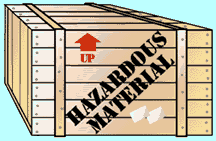|

Last month, we looked at some
of the results of taxiway and runway incursion incidents. This month,
we focus on a specific taxiway incursion issue encountered by pilots at
a number of busy airports. An air carrier pilot explains the problem:
- We landed
on runway 36, and were instructed to hold short of taxiway Z, which
is the parallel taxiway for runway 36. In order to be sure the tail
of the aircraft was clear, I taxied onto taxiway Z. The Controller got
upset. We indicated that the only way to insure that our tail was clear
was to taxi onto Z, since Tower had already cleared an airplane for
takeoff behind us. We also stated that we believed it was appropriate
that no part of the aircraft be beyond the hold line (between the hold
line and the active runway).
When pilots are clearing runways with large aircraft, they have no way
of exactly determining when their tail is clear of the runway....Many
controllers do not understand that if a widebody is on the centerline
of a runway, its wingtips [may] extend beyond the edge of the runway.
It is not acceptable for wingtips to touch the tails of other aircraft
[holding on an adjacent taxiway].
Several other reporters have
faced the same problem:
- The distance
between the runway and the parallel taxiway is so narrow that a widebody
whose tail is clear of the runway will have its nose into the parallel
taxiway.
- Tower issued
instructions to clear the runway and hold short of the parallel taxiway.
We couldn't do both. If we held short of the taxiway, it looked like
our tail would be over the line and not clear of the runway.
- [On takeoff
roll], I saw the previous aircraft's tail sticking out about 20 feet
onto the runway. The First Officer swerved andwe both felt we had missed
the other aircraft. [At our destination], we found a piece of the left
wing leading edge missing.
Normally, ATC will provide
taxi instructions if an aircraft is required to enter a taxiway or runway
in order to clear the landing runway. However, the Air Traffic Control
Handbook (7110.65J) states:
"In the absence of ATC instructions, an aircraft should taxi clear
of the landing runway even if that requires the aircraft to protrude into
or enter another taxiway/runway/ramp area. This does not authorize an
aircraft to cross a subsequent taxiway/runway/ramp area after clearing
the landing runway. The pilot is responsible for ascertaining when the
aircraft is clear of the runway."
The AIM discussion of the procedure for exiting runways after landing
can be found in section 4-3-20.
The hazards associated with this issue are not confined to large aircraft.
A general aviation pilot was on the receiving end of a Boeing 747 letting
it all hang out:
- Ground cleared
me to taxi to the hangars. I taxied onto taxiway X, and began slowing
down because a B747 was on the intersecting taxiway with part of its
tail sticking into taxiway X. Ground told me to taxi behind the B747
and to use caution. I should have told Ground that I would hold until
the B747 taxied onto the runway, but I assumed Ground was holding the
B747 in position until after I passed behind. Just as I got almost even
with the B747's wingtip, I heard the jet's engines increase power. My
Cessna was immediately pushed to the left and forward, and pitched nose
down. I brought the aircraft to a stop, but not until after the wingtip
and the prop contacted the ground.
For small aircraft, jet blast
on the ground can be almost as dangerous as wake turbulence in the air.
As the reporter indicates, waiting for the jet to clear the taxiway would
have been the prudent choice.
"Cell"
Save
Any in-flight emergency is
an adrenaline-producing event, but a forced landing over water is the
stuff nightmares are made of. The crew of a helicopter equipped with inflatable
floats makes the situation sound almost routine.
- After completing
the after-takeoff checklist, we heard a buzzing sound, then a vibration,
followed by a main transmission chip caution light illumination. The
Captain executed memory item checklist, "land immediately [and]
arm the floats." Then, at the right time, he commanded, "blow
the floats." The aircraft made a gentle landing on the water. There
were no injuries or airframe damage. Upon landing, I used our handheld
cellular phone and dialed 911. I described our location and situation
to a police dispatcher, who contacted the Coast Guard. Approximately
10 minutes later, they arrived alongside....We towed the aircraft to
the shore, where it was recovered. Good training and a little luck resulted
in a happy ending.
This report highlights the
value of cellular phones for providing back-up communication during electrical
failures and other emergencies.
Hazmat
Revisited
 ASRS
occasionally receives reports regarding the carriage of hazardous materials
on aircraft, a subject much in the public eye, lately. Whether in the
passenger cabin or in the cargo hold, these materials can present a significant
hazard if not properly packaged, labeled, stowed, and listed on a pilot's
load manifest. Although the following ASRS report is of 1988-vintage,
it is an example of how serious--and costly--hazardous material incidents
can be. ASRS
occasionally receives reports regarding the carriage of hazardous materials
on aircraft, a subject much in the public eye, lately. Whether in the
passenger cabin or in the cargo hold, these materials can present a significant
hazard if not properly packaged, labeled, stowed, and listed on a pilot's
load manifest. Although the following ASRS report is of 1988-vintage,
it is an example of how serious--and costly--hazardous material incidents
can be.
- As we were
being vectored for final approach, a Flight Attendant called from the
main cabin and informed the First Officer (FO) that there were fumes
of unknown origin in the cabin. The FO kept in constant contact with
the cabin crew in an effort to identify the fumes and locate the source.
As we were turning final, a deadheading FO advised that the floor in
the area of the landing gear was hot. When we heard "gear area,"
we elected to extend the gear immediately. I landed the aircraft and
taxied off the runway. The deadhead FO informed us that the floor was
hot and mushy, and he thought there might be smoke. We initiated a ground
evacuation. The crew performed admirably well.
After completion of the evacuation, the middle cargo bay was opened.
The sight of smoke coming out of the bay proved that our decision to
evacuate immediately had been prudent. It turned out that illegally-shipped
sodium hydroxide [caustic lye], in chemical reaction with something,
caused the smoke and heat, and probably the fumes as well. The cargo
was marked "laundry equipment," so no special loading procedures
were used. Temperature in the cargo compartment reached 600-800 degrees.
At this time, the aircraft is being declared a total loss because of
possible keel beam damage.
More recent examples from the
ASRS database include:
Even such everyday items as
insect repellent, fingernail polish remover, and household cleaning liquids
may leak and release unpleasant fumes. The chemicals in these products
may also react with other materials to create a dangerous environment
for flight crew and passengers. All of us--pilots, ground crew, cabin
crew, and passengers--are responsible for ensuring that carry-on baggage
and cargo do not present a safety hazard to the aircraft and its passengers.
Hot Days, Cool Heads
In hot weather, air molecules
expand, resulting in fewer air molecules flowing under and around airfoils
to give them lift. Under these conditions (known as high density altitude),
an aircraft will perform as if it is at a higher elevation than it actually
is, and pilots may be robbed of the performance they usually count on.
The additional impact of operating at maximum gross weight may put the
aircraft beyond its capacity to fly normally, as this reporter found out:
- The operation
was agricultural dispensing. Aircraft was loaded at close to gross weight.
This was during a heat wave with temperatures 95-100 degrees, humidity
70-90%. The density altitude was 2,400 feet. Fields to be sprayed had
obstacles, including two areas which were considered congested. I completed
the long rows to get rid of as much weight as possible to increase aircraft
performance before working the tight places. On several of the turns
near the congested areas, I had to pull tighter than I thought to prevent
overflight. As time progressed, the wind diminished to nothing. On one
pass I caught some turbulence from a previous pass and, in order to
maintain controlled flight, I had to overfly a congested area at approximately
200 feet AGL. The higher than normal density altitude created a situation
where I tried to ask the aircraft for more than it could deliver performance-wise.
Alternatively, high density
altitude may appear to be the cause of poor performance, when a mechanical
malfunction is the real culprit. A general aviation pilot reports:
- On an 85-degree
day, I noticed a longer than normal takeoff roll and very poor rate
of climb. I thought it was probably normal considering a 100-horsepower
aircraft, fully loaded on a hot day, but decided to return for landing
anyway just to be safe. The mechanic discovered that the carb heat cable
needed adjustment, and carb heat may have been partially on when the
carb heat control was off. Later test flight found normal performance.
The pilot who flew the plane before me also noted poor performance,
but continued flight thinking it was only a result of high density altitude.
ASRS Recently Issued Alerts
On...
- Dual generator failure on
a B737-200
- Autopilot rate gyroscope
failure in a B747-100
- Smoke hazard from overheated
fluorescent light ballast
- DC-9 rudder deflections
attributed to autopilot malfunction
- Erroneous altimeter readings
caused by an electrical surge
May 1996 Report Intake
- Air Carrier Pilots--1891
- General Aviation Pilots--682
- Controllers--107
- Cabin/Mechanics/Military/Other--27
- TOTAL--2707
|

